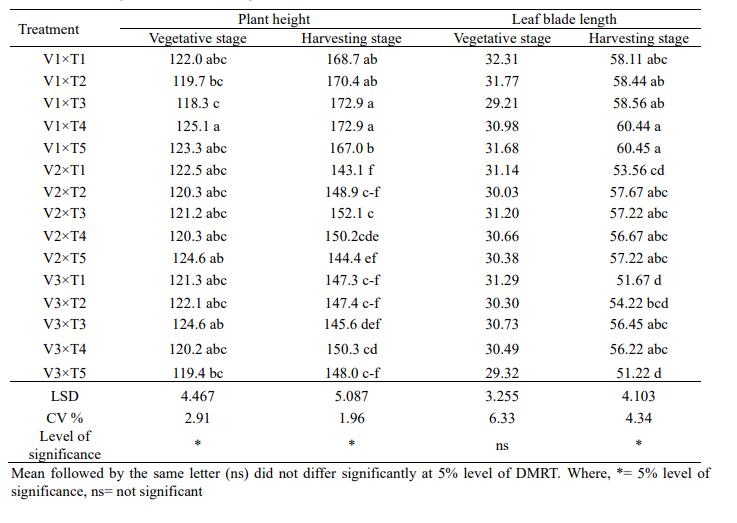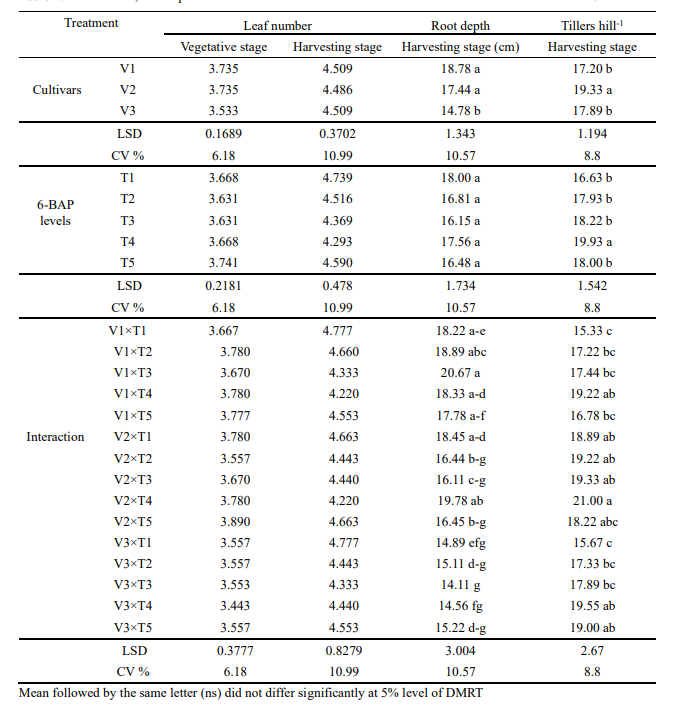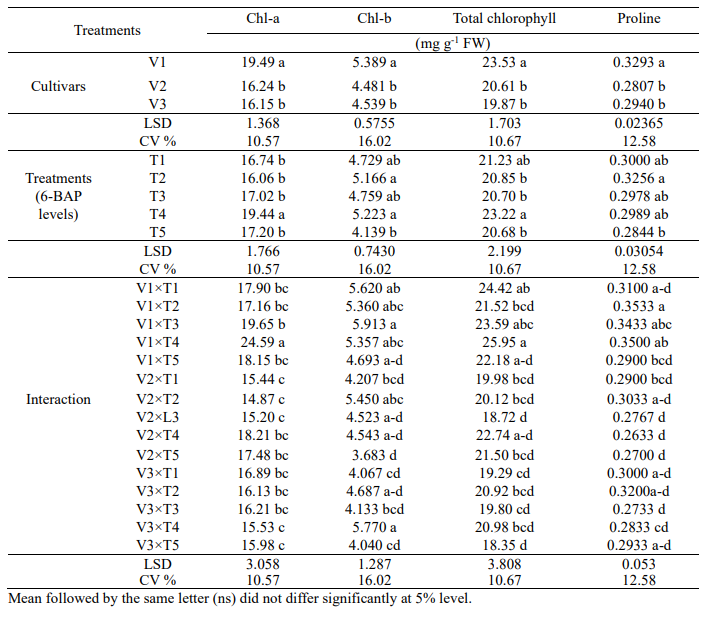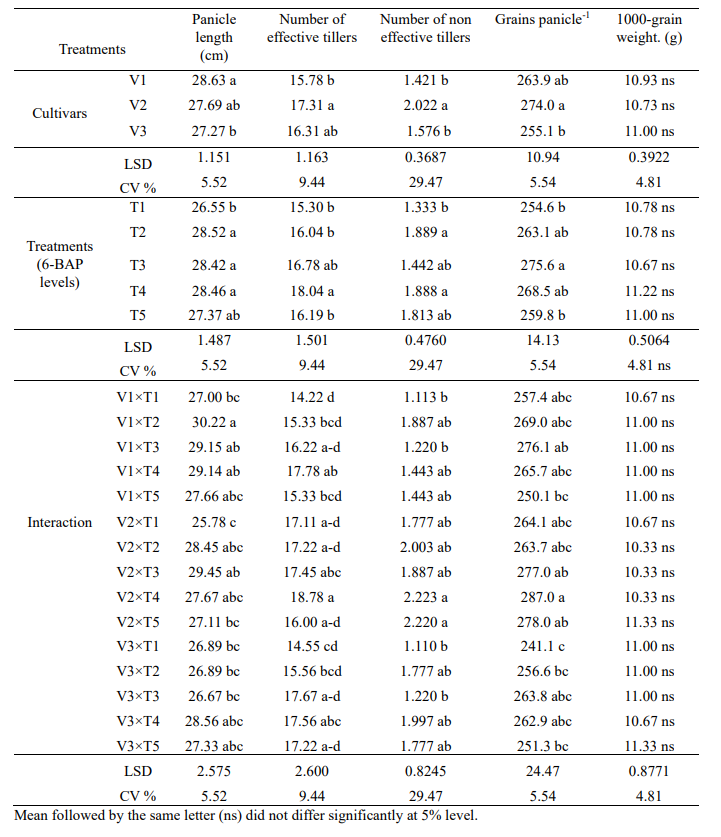Morpho-physiological
characteristics and yield attributes of three aromatic rice cultivars
in response to 6-BAP
Bikash
C Sarker*, Pobitra Rani Minjee, Zannata Uma Nisu, Md Jahidul
Islam and Md Jafar Ali
Department
of Agricultural Chemistry, Faculty of Agriculture, Hajee Mohammad
Danesh Science and Technology University, Dinajpur 5200, Bangladesh
Article
history: Received: 07.09.2020, Accepted:
10.12.2020, Published Online: 31.12.2020
*Corresponding
author:bikash@hstu.ac.bd
www.isciencepub.com
ABSTRACT
A
field experiment was conducted to study the effect of 6-Benzyl
aminopurine (6-BAP) on growth, physiology, yield and yield attributes
of three aromatic rice cultivars cv. Chinigura, Kataribhog and
Kalijira. The 6-BAP was applied 0, 20, 40, 60 and 80 ppm at
vegetative and pre flowering stages. There was a significant
variation among the cultivars and different levels of 6-BAP on both
vegetative and harvesting stage on tillers hill-1,
leaf length, root depth, panicle length, effective and non-effective
tillers hill-1,
grain yield, harvesting index, chlorophyll-a, chlorophyll-b, total
chlorophyll content, and proline content except straw yield and
1000-grain weight. The highest plant height (172.9 cm) was in cv.
Chinigura with 60 ppm 6-BAP. The highest panicle length was found in
Chinigura with 20 ppm 6-BAP and the lowest was found in Kataribhog
with control treatment. The maximum number of grains panicle-1(287)
was found in Kataribhog treated with 60 ppm 6-BAP and the minimum
number of grains (241.1) in Chinigura under the control. The maximum
amount of chlorophyll-a (24.59 mg g-1 FW)
was in Chinigura with 60 ppm 6-BAP and the lowest amount (14.87 mg
g-1 FW)
was recorded in Kataribhog with 20 ppm 6-BAP. The highest amount of
total chlorophyll content (25.95 mg g-1 FW)
was in Chinigura with 60 ppm 6-BAP while the lowest amount (18.35 mg
g-1)
was in Kalijira with 80 ppm 6-BAP. The highest proline content (0.353
mg g-1 FW)
was recorded in Chinigura with 20 ppm 6-BAP. The Kataribhog produced
the highest yield (1.67 t ha-1)
treated with 60 ppm 6-BAP. The spraying 60 ppm 6-BAP had the better
stimulation on the growth and yield of Kataribhog while 80 ppm for
Chinigura. The study infers that 6-BAP enhanced yield of aromatic
rice cv. Chinigura which might be an alternative eco-friendly
management practices in rice farming business.
Keywords: Aromatic
rice, 6-BAP, chlorophyll, foliar spray, growth, yield
To
cite this article: Sarker BC, Minjee PR, Nisu ZU, Islam MJ
and Ali MJ. 2020. Morpho-physiological characteristics and yield
attributes of three aromatic rice cultivars in response to 6-BAP.
Intl. J. Agric. Med. Plants. 1(1):1-9.
INTRODUCTION
Rice
(Oryza sativa L.)
is the staple cereal food for about half portion of the world's
populace. The annual production and consumption in Asia is
approximately 90%, but average yield of rice grain in this region is
low compared to global average yields (Haider 2018). Bangladesh
is the 4th largest rice growing country of the world based on rice
growing area and production including coarse and fine aromatic rice
(BBS 2016). Aromatic rice contributes a little but unique group
of rice and has increased greater significance with the overall
increment in the demand for fine quality rice. Now a day, aromatic
rice has been introduced to the global market. In recent years, the
demand of aromatic rice is gradually increasing markedly for both
local and global market. Interestingly, the aromatic rice regularly
has unfortunate agronomic characters, for example, low yield,
weakness to nuisances and ailments, and solid shedding (Faruq et al.
2011). Use of the plant growth regulators (PGRs) in rice has been one
of the most potential tools for increasing crop production. PGR as
either naturally or synthetic compounds that are applied directly to
a target plant to alter its physiological processes or its structure
to improve quality, increase yields, or facilitate harvesting
control, undesirable vegetative growth of crop plants, enhancing
fruiting bodies. Similar PGRs areactive in different stages of the
same plant in different ways. An exogenous application of plant
growth regulators affects the endogenous hormonal pattern of the
plant, either by supplementation of sub-optimal levels or by
interaction with their synthesis, translocation or inactivation of
existing hormone levels. Hormones regulate physiological process and
synthetic growth regulators may enhance growth and development of
field crops thereby increased total dry mass of a field crop (Das and
Das 1996, Chibu et al. 2000, Cho et al. 2008).
Application
of 6-BAP found to increase plant height, number of leaves plant-1,
natural product measure with resulting upgrade in seed yield in
various plants. The uses of growth substances such as 6-benzyl
aminopurine (6-BAP), NAA, GA3 and some others at
different concentrations increased aromatic rice grain production
(Sarker et al. 2020). It is certain that endogenous and exogenous
plant development controllers assume a vital job in adjusting and
directing numerous physiological procedures in plants and these
procedures are significantly affected by natural conditions. Although
some exploration works were done and a few high yielding aromatic
rice cultivars were released by Bangladesh Rice Research Institute,
our indigenous cultivars were given less attention and their yielding
ability was not studied well by using plant growth regulators.
Research on aromatic rice using 6-BAP is limited in Bangladesh.
Findings in using different PGRs for increasing rice yield in some
countries that certainly provide valuable information; those can't be
prescribed without preliminary field trial in Bangladesh. Therefore,
more researches are necessary to investigate the efficacy of 6-BAP on
aromatic rice production. Thus, the objective is to study the growth
characteristics, physiology and yield potentials of three selected
aromatic rice cultivars in response to 6-BAP.
MATERIALS
AND METHODS
A
field study was conducted at the research farm of the Department of
Agricultural Chemistry, Hajee Mohammad Danesh Science and Technology
University (HSTU), Dinajpur, Bangladesh during Aman season
(July to December, 2017). The experimental area possesses subtropical
climatic condition. The air temperature was relatively high (25-32oC)
at the beginning of the season and was decreasing (20-26oC)
with advancement of the season towards aman with occasional gusty
winds. The experiment was laid out in a factorial randomized complete
block design (RCBD) with three replications. The experiment comprised
three aromatic rice cultivars namely, Chinigura (V1),
Kataribhog (V2),
Kalijira (V3)
and five levels of 6-BAP at the rate of 0 ppm (T1,
control), 20 ppm (T2),
40 ppm (T3),
60 ppm (T4)
and 80 ppm (T5)
spraying twice at vegetative and pre-flowering stages. The solution
of BAP 0, 20, 40, 60, and 80 ppm was prepared by dissolving 0, 20,
40, 60, and 80 mg of 6-BAP powder in a litre measuring cylinder in
which 5 mL of ethanol prior to dilution was made in distilled water
for quick miscible. Forty-day old healthy seedlings were transplanted
on puddle plots on 10
July, 2017 according to the experimental design. Three seedlings
of the selected aromatic cultivars were transplanted in each hill
with a spacing of 15 cm×20 cm.
The
data on different growth parameters like plant height, leaf number
plant-1,
leaf blade length, tillers hill-1 were
recorded at seedling, vegetative and harvesting stages. The
physiological characteristics like flag leaf chlorophyll-a,
chlorophyll-b, total chlorophyll and total carotenoid content were
estimated by acetone extract method following Arnon (1949) while
proline at flowering stage was estimated by Bates et al. (1973). The
yield and yield contributing parameters- panicle length, number of
effective tillers hill-1,
number of non-effective tillers hill-1, grains
panicle-1, filled
grains panicle-1,
unfilled grains panicle-1,
1000-grain weight, grain yield (t ha-1),
straw yield (t ha-1),
and harvest index (%) were recorded at harvest. The data were
statistically analyzed to compare treatment means using the MSTAT-C
package. If the treatments were significant the differences between
pairs of means were compared by LSD followed by DMRT.
RESULTS
AND DISCUSSION
The
height of rice plant at different growth stages was markedly
influenced by the application of6-BAP in aromatic rice cultivars
which have been presented in Table 1. Result shows that highest plant
height was 125.1 cm in V1×T4 at
their vegetative stage. At harvest, the highest plant height was
observed in V1×T4 and
V1×T3 (172.9
cm) which was statistically identical to V1×T1 and
V1×T2 (168.7
and 170.4 cm), respecesistance and remains stand against strong wind.
Khanam (2016) reported
that application of 6-BAP showed better performance on plant height
of Kataribhog than those of other two cultivars (Chinigura and
Kalijira) studied at both vegetative and harvesting stages.
Result
showed that the ltively. The lowest plant height (143.1 cm) was
recorded in V2×T1.
The plant height of V1 was
more taller than V2 followed by V3 plants. The shorter plant is an
important desirable index for lodging reaf
blade length was insignificant at their vegetative stage but
harvesting stage. The leaf blade length of three aromatic rice
cultivars at harvesting stage was influenced by the application of
6-BAP which have been presented in Table 1. The longest leaf blade
(60.45 cm) was observed in V1×T5 which
was at par with V1×T4 (60.44
cm) while the shortest leaf blade (51.22 cm) was 51.22 cm in (V3×T5)
which was also statistically identical with V3×T1 (51.67
cm).
Table
2 shows
the number of leaves produced by the three aromatic rice cultivars in
the present study. There was no significant effect of 6-BAP on the
number of leaves in three different cultivars. The root depth of
three aromatic rice cultivars at different growth stages was
influenced by the application of 6-BAP which are shown in Table 2.
Among the aromatic rice cultivars, Kataribhog and Chinigura showed
better performance to extend root in the soil and 6-BAP treatments
had no significant effect. The highest root depth was
observed 20.67cmin V1×T3 while
the lowest root depth was 14.11 cm in V3×T3 plants.
Khanam (2016) revealed that highest root depth was obtained from
Kataribhog rice cultivar spraying at 200 ppm 6-BAP.
The
major chlorophylls in flag leaf of aromatic rice is chlorophyll-a,
which has a methyl group at C-3 carbon, and chlorophyll-b, which a
formal group is bonded to the same carbon atom. Table 3shows that,
there is a significant effect among the cultivars, levels and
interaction on chlorophyll-a, chlorophyll-b, total chlorophyll and
proline content of flag leaves in studied three cultivars of aromatic
rice. Cultivar Chinigura contained the highest chlorophyll-a among
the three cultivars studied and spraying of 60 ppm showed the better
stimulating effect. The maximum amount of chlorophyll-a was in V1×T4
(24.59 mg g-1FW) and the lowest amount was found inV2 × T2
(14.87 mg g-1FW).
Chlorophyll-b
absorbs energy from wavelengths of green light at 640 nm. It is the
accessory pigment that collects energy and passes it on to
chlorophyll-a. It also regulates the size of antenna and is
moreabsorbable than chlorophyll-a. Thus, chlorophyll-a is the primary
photosynthetic pigment while chlorophyll-b is the accessory pigment
that collects energy. Therefore, the amounts of chlorophyll-b in flag
leaves of rice plant have a significant impact on the production of
photosynthate resulting in grain production. Maximum chlorophyll-b
was 5.913 mg g-1 FW in V3×T1 which was statistically identical
with V1×T1 (4.04 mg g-1) and the lowest amount was found in
V2×T5 (3.68 mg g-1 FW).
Table
1. Plant height and
leaf blade length of three aromatic rice cultivars under different
levels of 6-BAP

The
interaction effect between cultivars and 6-BAP levels regarding total
chlorophyll content also statistically significant which is presented
in Table 3. Among the BAP levels applied, 60 ppm (T4) BAP
showed the better performance on Chinigura. From the interaction, the
highest total chlorophyll content was 25.95 mg g-1 with
V1× T4 and the lowest value was V3×
T5 (18.35 mg g-1) which was statistically
identical with V2×T3 (18.72 mg
g-1 FW).
Regarding
proline content in flag leaves, there were significant differences
among the varieties, BAP levels as well as interactions (Table 3).
Spraying 20 ppm of BAP at pre-flowering stage, Chinigura produced
more proline in comparison to others two varieties. From the
interaction, the maximum proline content was 0.353 mg g-1 found
in V1×T2 and the lowest was 0.2633
mg g-1 in V2×T4 which
was statistically identical with V2×T3 (0.277
mg g-1 FW),V2×T5 (0.270
mg g-1 FW), and V3×T3 (0.273
mg g-1 FW), respectively. NAA while cv. Kataribhog
showed better performance at 100 ppm and Kalijira showed better
performance at 200 ppm of NAA, respectively (Sarker et al. 2020).
Table
2. Leaf number,
root depth and tiller number of three aromatic rice cultivars under
different levels of 6-BAP

Number
of effective tillers hill-1: There
was a significant variation among the cultivars and levels of
aromatic rice on the production of effective tiller hill-1.
Among the cultivars, cv. Kataribhog had the higher number of
effective tiller hill-1 while
spraying with 60 ppm (T4)
6-BAP at vegetative and pre flowering stages. From the interaction,
the maximum number of effective tiller hill-1 was
found in V2×T4 (18.78)
and the lowest number of tiller hill-1 was
in V1×T1 (14.22)
in the controlled plot. Khanam (2016) reported that the highest
number of effective tillers hill-1wasfrom
Kataribhog rice cultivar while 100 ppm 6-BAP was applied.
Number
of non-effective tiller: Spraying
different levels of 6-BAP on non-effective tillers hill-1 was
significant which presented in Table 4. The non-effective tillers
hill-1 reduced
due to effect of 6-BAP. Result showed that maximum non-effective
tiller was in V2×T4 (2.22)
which was statistically identical with V2×T5 (2.22).
The result was in agreement with Khanam (2016) that the highest
number of non- effective tillers hill-1 from
Kataribhog rice at control treatment.
Table
3. Chlorophyll
and proline content of flag leaf of three aromatic rice cultivars
under different levels of 6-BAP

Grains
panicle-1: There
is a significant effect of 6-BAP on the cultivars and grain –number
per panicle was statistically varied due to application of different
levels of 6-BAP. Among the cultivars, Kataribhog spraying with 40 ppm
6-BAP (T4)
showed the better performance to produce grain number per panicle.
The interaction effect of 6-BAP and cultivars was also significant
for producing grain number per panicle (Table 4). The highest number
of grains panicle-1 (287.0)
was observed at V2×T4 while
the lowest one (241.1) was recorded inV3×T1 .In
this study 40 ppm BAP on cv. Chinigura showed better performance on.
Table
4. Effect of
cultivar, 6-BAP levels and their interaction on yield contributing
characters of aromatic rice.

Table
5. Effect of
cultivars, 6-BAP levels and their interaction on yield and harvest
index of aromatic rice

grains
panicle-1of
rice cultivar. Cultivar Kataribhog showed better performance at 60
ppm and Kalijira showed better performance at 40 ppm 60 ppm of 6-BAP
than that of other levels. Sarker et al. (2020)
stated that 150 ppm NAA on Kalijira showed better performance on
grainspanicle-1 of
rice cultivar than those of cv. Chinigura and cv. Kalijira. Similar
result was reported by Roxy (2016) who noted that50 ppm BAP increased
the grainspanicle-1 in
Kataribhog.
1000-Grain
weight: There is a no
significant effect of 6-BAP on 1000-grain weight either in the
varieties or levels also among the interaction of cultivars and
levels (Table 4). Khanam (2016) also reported that Kataribhog
produced the highest 1000-grain weight while 50 ppm 6-BAP was
applied. Kabir et al. (2004) studied with aromatic rice cv.
Begunbitchi, Chinigura and Kalijira and reported that Chinigura
produced the highest 1000-grain weight. Rahman et al. (2012)
revealed that 100 ppm NAA plants than those of BAP treated
plants. Among the cultivars, Kataribhog applying 60 ppm 6-BAP showed
the better stimulating effect on grain production. Kataribhog
produced the highest grain with 1.0 ton lime residual effect showed
the best performance of yield contributing characters in Kataribhog
rice such as number of filled grain, 1000-grain weight and grain
yield.
Grain
yield: The
studied aromatic rice cultivars and different levels of 6-BAP were
interacted significantly with each other in respect to grain yield
which was presented in Table 5. There was also a significant effect
among the cultivars and different levels of 6-BAP. All the cultivars
produced lower yield in controlled plants than those of BAP treated
plants. Among the cultivars, Kataribhog applying 60 ppm 6-BAP showed
the better stimulating effect on grain production. Kataribhog
produced the highest grain with 1.0 ton lime residual effect showed
the best performance of yield contributing characters in Kataribhog
rice such as number of filled grain, 1000-grain weight and grain
yield.
yield
(1.67 t ha-1)
using 60 ppm BAP while the lowest yield (0.75 t ha-1)
was obtained in Kalijira under control. It was observed that the
average yield of grain was relatively lower than the national average
(1.90 t ha-1)
might be due to sudden stormy wind and heavy showering resulting
lodging and poor grain formation. yield (1.67 t ha-1)
using 60 ppm BAP while the lowest yield (0.75 t ha-1)
was obtained in Kalijira under control. It was observed that the
average yield of grain was relatively lower than the national average
(1.90 t ha-1)
might be due to sudden stormy wind and heavy showering resulting
lodging and poor grain formation. In the present study, 6-BAP effect
was variable on the three aromatic rice cultivars regarding the grain
yield. Chinigura showed better performance at 80 ppm, while
Kataribhog and Kalijira performed at 60 ppm, respectively.
Application of 6-BAP significantly increased yield and yield
components of aromatic rice (Roxy 2016, Khanam 2016).
Straw
yield: There is
no significant effect of BAP on straw yield of the aromatic rice
cultivars (Table 3). Several authors found that there was no
positive effect of BAP (Roxy 2016) and NAA (Rahman et al. 2017)
application on straw yield of different rice cultivars.
Harvest
index (%): The
harvest index (%) is an important yield determining character which
can through idea along partitioning efficiency. Table 5 showed that
harvest index was not influenced due to the interaction effect of
cultivar, and levels of 6-BAP.Among the cultivars, Kataribhog showed
the better performance and BAP treatments had no significant effect
of %HI. From the interaction, the highest harvest index
V2×T4 (33.80%)
which was statistically similar with V2×T3 (33.66
%) and V2×T5 (33.46
%), respectively. The lowest %HI was found in V1×T5 (20.5
7%). Roxy (2016) found that the highest harvest index 39.24% at 50
ppm 6-BAP. Khanam (2016) reported that 100 ppm 6-BAP produced highest
harvest index. Rahman (2017) found the highest harvest index (49.60%)
which obtained from BRRI dhan28 with 100 ppm NAA and the lowest
harvest index (42.01%) which obtained from the Nerica-4 without
GA3 or
NAA.
CONCLUSION
It
is concluded that growth and physiological parameters of aromatic
rice cultivars were increased by the twice application of 6-BAP. Most
of the yield and yield contributing parameters quantitatively
increased by the concentration of 60 ppm BAP on Kataribhog rice
cultivar than that of Chinigura and Kalijira. In regard to all
parameters, application of 60 ppm BAP on Kataribhog rice cultivar
performed the best regarding the yield and yield components. It is
concluded that aromatic rice Kataribhog and Kalijira showed better
performance at 60 ppm while Chinigura showed better performance at 80
ppm and may the recommended for the farmers’ level BAP, a
growth regulator might be useful to increase aromatic rice production
which is an environment-friendly tool for agricultural management
practices. BAP, a plant growth regulator might be useful to increase
aromatic rice production which is an environment-friendly tool for
fine rice farming practices.
REFERENCES
Almela
L, Fernandez-Lopez JA and Roca MJ. 2000. High-performance liquid
chromatographic screening of chlorophyll derivatives produced during
fruit storage. Journal of Chromatography. 870: 483-489.
Arnon
DI. 1949. Copper enzymes in isolated chloroplasts, polyphenol oxidase
in Beta
vulgaris L. Plant
Physiology. 24: 1-15.
Bakhsh
I, Awan IU, Baloch MS, Khan EA and Khakwani AA. 2012. Effect of
plant growth regulator (NAA) and irrigation regimes on yield of
transplanted coarse rice. Sarhad Journal of Agriculture. 28(4):
539-544.
Bates
LS, Waldren RP and Teare ID. 1973. Rapid determination of free
proline for water stress studies. Plant and Soil. 39: 205-207.
BBS
(Bangladesh Bureau of Statistics). 2016. The Year Book of
Agricultural Statistics of Bangladesh. Stat. Div. Ministry of
Planning.Govt. Peoples Republic of Bangladesh, Dhaka. pp. 96.
Chibu
H, Shibayama H, Mitsutomi M and Arima S. 2000.Effects of chitosan
application on growth and chitinase activity in several crops.Marine
and Highland Bioscience Center Report. 12: 27-35.
Cho
MH, No HK and Prinyawiwatkul W. 2008. Chitosan treatments affect
growth and selected quality of sunflower sprouts. Journal of Food
Science. 73: 570-577.
Das
BC and Das TK. 1996. Studies on the response of GA3,
NAA and Ethrel on the vegetative growth and yield of pumpkin. Orisssa
Journal of Horticulture. 24: 74-78.
Faruq
G, Yin YH, Masitah A, Afnierna N, Majid NA, Khalid N and Osman
M. 2011. Analysis of aroma
and
yield components of aromatic rice in Malaysian tropical
environment. Australian Journal of Crop Science. 5(11):
1318-1325.
Haider
IK. 2018. Appraisal of biofertilizers in rice: To supplement
inorganic chemical fertilizer. Rice Science.25: 357–362.
Kabir
ME, Kabir MR, Jahan MS and Das GG. 2004. Yield performance of three
aromatic fine rice in a coastal medium high land. Asian Journal of
Plant Sciences. 3(5): 561-563.
Khanam
N. 2016. Growth, leaf chemical parameters and yield of aromatic rice
cv. Chinigura under different levels of 6-BAP. M.S. Thesis.
Department of Agricultural Chemistry, Hajee Mohammad Danesh Science
and Technology University, Dinajpur, Bangladesh.
Lee
HS. 1990. Effect of pre-sowing seed treatment with GA3 and
IAA on flowering and yield components of groundnut. Korean Journal of
Crops Science. 35(1): 1-9.
Liu
Y, Chen W, Ding Y, Wang Q, Li G and Wang S. 2012. Effect of
gibberellic acid (GA3)
and naphthalene acetic acid (NAA) on the growth of unproductive
tillers and the grain yield of rice (Oryza
sativa L.).
African Journal of Agricultural Research. 7(4): 534-539.
Rahman
MS, Sarker BC, Roy B and Habib MA. 2017. Performance of growth and
yield attributes of rice (Oryza
sativa L.)
varieties influenced by plant growth regulators. Journal
of Innovative Agriculture. 4(2): 20-28.
Roxy
A. 2016. Effect of different levels of 6-BAP on growth, chemical
properties and yield performance of aromatic rice cv. Kataribhog. M.S
Thesis. Department of Agricultural Chemistry, Hajee Mohammad Danesh
Science and Technology University, Dinajpur, Bangladesh.
Sarker
BC, Sharmin N, Bhadhury SK and Nisu ZU. 2020. Effect of
naphthalene acetic acid on morpho-physiological and yield traits of
three aromatic cultivars. International Journal of Scienceand
Research. 9(1): 519-523.
Sarker
BC, Roy B, Fancy R, Rahman W and Jalal S. 2009. Response of root
growth and yield of rice (BRRI dhan28) under different irrigation
frequencies and plant growth regulator. Journal of Science and
Technology. 7: 143-148.
Singh
PK, Misra CH and Sharma CL. 2003. Effect of foliar gibberellic acid
on seed set and yield contributing character in hybrid rice. New
Agriculturist. 14(1/2): 71-74.
Tonucci
LH and Von-Elbe JH. 1992. Kinetics of the formation of zinc complexes
of chlorophyll derivatives. Journal of Agricultural and Food
Chemistry. 40: 2341-2344.
Yang
L, Weiping C, Yanfeng D, Qiangsheng W, Ganghua L and Shaohua W. 2012.
Effect of Gibberellic acid (GA3)
and α-naphthalene acetic acid (NAA) on the growth of
unproductive tillers and the grain yield of rice (Oryza
sativa L.).
African Journal of Agricultural Research. 7(4): 534-539.
Zahir
A, Zahir M, Iqbal M, Arshad M and Khalid M. 2007. Effectiveness of
IAA, GA3 and
Kinetin blended with recycled organic waste for improving growth and
yield of wheat (Triticum
aestivum L.).
Pakistan Journal of Botany. 39(3): 761-768.




